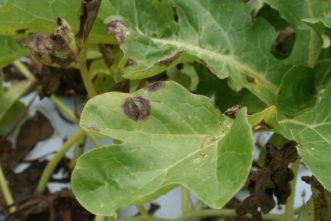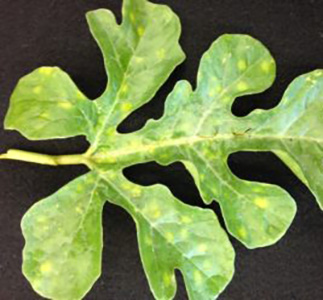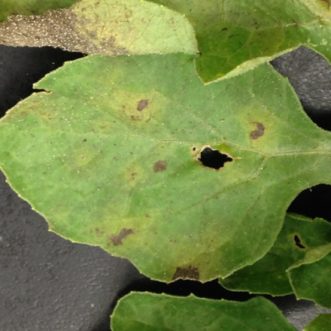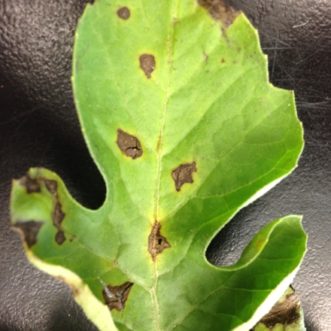The information provided below is current at this time. If any updates are made to the information below, the corresponding year in which the updates are made will be included in the publication title.
Four foliar diseases reduce watermelon yields in South Carolina. Gummy stem blight and powdery mildew are the most common diseases in spring crops.1
Gummy stem blight is large, round spots on the edges of leaves and dry cankers on the main stem (figure 1). The best fungicides are Miravis Prime or Inspire Super. Powdery mildew is yellow spots on the top of leaves and white powdery mildew on the bottom (figure 2). It shows up during dry periods. The best fungicides are Gatten or Vivando. The new fungicide Prolivo is not recommended because it is less effective on the bottom of leaves than other powdery mildew fungicides.2
Downy mildew starts as brown or yellow, round or irregular spots that spread quickly (figure 3). If seen, spray immediately with Ranman or Orondis Ultra, followed by the other fungicide the next week. Anthracnose starts as dark, irregular spots with points like a star (figure 4). It also affects vines and young fruit. The best fungicides are Flint Extra, Cabrio, mancozeb, or chlorothalonil.
Scouting for Diseases
- Walk fields weekly and the day before spraying.
- Yellow spots on leaves are symptoms of powdery mildew or downy mildew. Look for spores on the underside of leaves in the early morning. Call your local Clemson Cooperative Extension office if you can’t identify the disease.
- Brown spots are usually gummy stem blight or anthracnose. Anthracnose also shows up as tan, narrow, sunken spots on vines.
How to Get the Most Out of Spraying
Table 1 provides details for fungicide spray programs for spring and fall crops. Follow these steps to get the most out of your fungicide program.
- Rotate fields to crops other than cucurbits for two years in between watermelon and cantaloupe to help control gummy stem blight and anthracnose.3
- Start spraying when vines start to run, no later than when the first (male) flowers open.
- From vine run until mid-May, spray every ten days.
- After mid-May, spray every week through harvest regardless of the weather. Downy or powdery mildew can attack any time a crop goes more than a week without a fungicide.
- Apply fungicides, allowing time to dry, before a predicted rain rather than after.
- For best control after disease starts, use systemic fungicides (see option “b” in the first column of table 1).
- Do not stop spraying until one week before the final picking.4
Fungicide Programs
- Chlorothalonil and mancozeb protect against gummy stem blight, downy mildew, and anthracnose; chlorothalonil also protects against powdery mildew.
- The spring program is designed to manage bacterial fruit blotch, bacterial leaf spot, gummy stem blight, powdery mildew, anthracnose, and downy mildew on watermelon.
- The fall program is designed to manage gummy stem blight, downy mildew, anthracnose, and powdery mildew.
- Week-by-week rotation is built into the spray programs for systemic fungicides, like tebuconazole, to reduce the risk of fungicide resistance.
- Tebuconazole and Inspire Super have a 7-day pre-harvest interval (PHI) on watermelon. These fungicides should not be sprayed during the harvest period (weeks 6-8 in the spray programs). When harvest begins early, skip ahead to spray number 6a or 6b listed in table 1. Mancozeb and Gavel have a 5-day PHI.
- See the current edition of the “Southeastern U.S. Vegetable Crop Handbook” for more information.5
Important Update for 2022: Resistance to Tebuconazole
Most (93%) samples of the gummy stem blight fungus collected in 2019 and 2021 from watermelon crops in South Carolina are moderately resistant to tebuconazole, the active ingredient in Monsoon, Folicur, and other products. Only 3% of the samples were sensitive, and 4% were highly resistant. The frequency of moderately resistant isolates on the seven farms sampled ranged from 69% to 100%.
Moderately resistant isolates were only 70% controlled by tebuconazole in greenhouse tests. This means when tebuconazole is sprayed, 30% of the treated foliage will likely develop gummy stem blight. Widespread resistance is why the number of tebuconazole sprays is limited to one at the beginning of the season in the 2022 update. Continued use of tebuconazole will shift the resistance to highly resistant, which means percent control is reduced to approximately 45%.
Do not increase the rate of tebuconazole as a way to continue using this inexpensive fungicide. Excess rates could lead to unlawful residues on fruit and phytotoxicity and will shift the population to highly resistant.
Table 1. Fungicide guide for watermelon.
| Spray Number | Fungicide Program for Spring Watermelon* | Comments on Spring Program | Fungicide Program for Fall Watermelon* | Comments on Fall Program |
| 1 (vine run) | mancozeb + fixed copper | To prevent bacterial leaf spot and fruit blotch. | chlorothalonil | – |
| 2 | chlorothalonil | If fruit blotch or bacterial leaf spot is a concern, use mancozeb + fixed copper instead. Do not tank mix copper with chlorothalonil. | chlorothalonil | – |
| 3a** | tebuconazole or Viathon | If fruit blotch is a concern, add fixed copper. | tebuconazole + Gatten | Apply Gatten if weather is unusually dry to prevent powdery mildew. |
| 3b** | or
tebuconazole + Flint Extra |
Add Flint if anthracnose fruit rot was found on your farm the previous year. | tebuconazole + Ranman | Apply Ranman if downy mildew has been reported on watermelon in your state. |
| 4 | chlorothalonil or mancozeb | If fruit blotch or bacterial leaf spots are a concern, substitute mancozeb + fixed copper. | Quadris Top | Quadris Top protects against anthracnose and gummy stem blight. |
| 5a** | mancozeb + Gatten | Starting week 5, use mancozeb to avoid injury to fruit on hot, sunny days. Note 5-day PHI on mancozeb. | Gavel | Gavel protects against anthracnose, gummy stem blight, and downy mildew. |
| 5b** | or Gatten + Inspire Super or Miravis Prime |
Use this program if gummy stem blight is present. If harvest has started, use Miravis Prime (1-day PHI). | Gavel | Gavel protects against anthracnose, gummy stem blight, and downy mildew. |
| 6a | Gavel | Note 5-day PHI on Gavel. | Miravis Prime | – |
| 6b | or mancozeb + plus Orondis Ultra | Tank mix Orondis products with mancozeb to protect against gummy stem blight and anthracnose. Apply Orondis if downy mildew has been reported on watermelon in your state. | Miravis Prime | – |
| 7a** | mancozeb + Vivando | If powdery mildew is a concern. | mancozeb + Ranman | If downy mildew is present. Note 5-day PHI on mancozeb. |
| 7b** | or Miravis Prime + Vivando | If gummy stem blight is present. | Miravis Prime | If gummy stem blight is present. |
| 8 | mancozeb + Ranman | – | chlorothalonil | – |
| 9-12 | If more sprays are needed after the eighth spray, repeat sprays 5-8 again until one week before the last harvest. | |||
*Fungicides for downy mildew are bolded and should be used if downy mildew has been reported on watermelon in the current season (check the Cucurbit Downy Mildew Forecasting website, cdm.ipmpipe.org). Fungicides for powdery mildew are underlined and should be applied all spring and during dry periods in the fall. Cantaloupe growers who are using this fungicide program can omit underlined fungicides for powdery mildew on hybrid varieties.
**Option “a” is a lower-cost treatment that may be less effective. Option “b” is a more expensive systemic fungicide that is more effective when disease is already in the field or when weather conditions favor disease getting worse.
References Cited
- Rennberger G, Gerard P, Keinath AP. Occurrence of foliar pathogens of watermelon on commercial farms in South Carolina estimated with stratified cluster sampling. Plant Disease 2018 Nov. 102(11):2285–2295. https://apsjournals.apsnet.org/doi/10.1094/PDIS-03-18-0468-RE.</li
- McGrath MT, Sexton ZF. Efficacy of fungicides for managing powdery mildew in pumpkin, 2016. Plant Disease Mangement Reports. 2017;11:V024. https://www.plantmanagementnetwork.org/pub/trial/pdmr/reports/2017/V024.pdf
- Rennberger G, Gerard P, Keinath AP. Factors influencing the occurrence of foliar pathogens in commercial watermelon fields in South Carolina based on stratified cluster sampling. Plant Disease 2019 Mar;103(3):484–494. https://apsjournals.apsnet.org/doi/10.1094/PDIS-07-18-1188-RE.
- Keinath AP. Effect of protectant fungicide application schedules on gummy stem blight epidemics and marketable yield of watermelon. Plant Disease 2000 Mar;84(3):254–260. https://doi.org/10.1094/PDIS.2000.84.3.254
- Kemble JM, senior editor. Bertucci M, Jennings KM, Meadows IM, Rodrigues C, Walgenbach JF, Wszelaki AL, associate editors. 2022 Southeast U.S. vegetable crop handbook. Sparta (MI): Great American Media Services. 2022. www.vegcrophandbook.com.
References Consulted
Rennberger G, Gerard P, Keinath AP. Occurrence of foliar pathogens of watermelon on commercial farms in South Carolina estimated with stratified cluster sampling. Plant Dis. 2018. 102: 2285-2295. doi:10.1094/PDIS-03-18-0468-RE.
Rennberger G, Gerard P, Keinath AP. Factors influencing the occurrence of foliar pathogens in commercial watermelon fields in South Carolina based on stratified cluster sampling. Plant Dis. 2019. 103: 484-494. doi:10.1094/PDIS-07-18-1188-RE.
Additional Resources
Keinath AP. Cucurbit downy mildew management for 2019. Land-Grant Press by Clemson Extension. 2022; LGP 1002. http://lgpress.clemson.edu/publication/cucurbit-downy-mildew-management.
Keinath AP, Rennberger G. Powdery mildew on watermelon. Land-Grant Press by Clemson Extension. 2022; LGP 1019. http://lgpress.clemson.edu/publication/powdery-mildew-on-watermelon.





